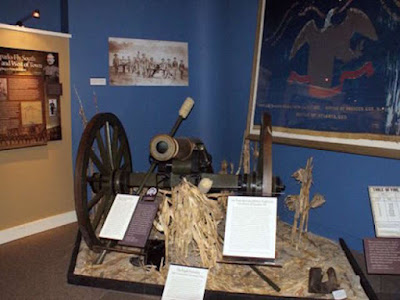What was I doing in Munfordville yesterday?
With a population of a whopping 1,518, it is the county seat of Hart County, Kentucky.
I've done pretty well tracing my roots on all the branches of my family tree, but when it came to one of my paternal great-great-grandfathers, Dr. Joel Compton Crouch (1826-1873), and his wife, my great-great-grandmother Ellen Victory Jarboe Crouch (1815-1875), I reached a dead end a long time ago. I have the names of Dr. Crouch's parents, my third great-grandparents, but no other information, and nothing on her parents.
The only thing I had to go on was that Joel and Ellen Crouch and their first-born child Charles show up in the 1850 U.S. Census for Hart County, Kentucky, with his profession listed as an innkeeper and hers as keeping house. (He went to medical school in Louisville soon after, served as a Union Army surgeon during the U.S. Civil War and eventually, after he and the family moved to Linn Creek, Missouri, became the town doctor).
I moved on to the Hart County Courthouse but learned that a fire in 1928 resulted in the loss of many records. Birth records only go back to 1852 and marriage records begin in 1928.
Then I went to the Hart County Historical Society & Museum, which, according to the website, was supposed to be open yesterday. It was all locked up.
Well, I tried. I guess I'll have to hire a local genealogist to try and solve the mystery.
This really lifted my spirits after the disappointing mornimg I experienced in Munfordville.
Abraham Lincoln was born Feb, 12, 1809, in a one-room log cabin at Sinking Spring Farm. He and his parents, Thomas and Nancy Hanks Lincoln, plus his older sister Sarah lived in the tiny dwelling on the farm, where a sunken natural spring supplied all the fresh water they could ever ask for.
I started at the visitor center, where I watched a film about Lincoln's early life in Kentucky and explored some exhibits.
This is the lobby.
I was fascinated by the true-to-size replica of what the interior of a small, one-room log cabin would have looked like. By today's standards it's hard to imagine a family of four living here.
So I went back to visitor center and learned about an elevated walkway that meanders about a quarter mile through the woods and ends at the back side of the memorial building.
It's too bad every visitor doesn't know about this! I didn't pass another person, coming or going. It was just beautiful and it served as my walk for the day (my medical team will be so happy).
There is a replica of what a typical one-room cabin during Lincoln's childhood would have looked like from the outside. It turns out the cabin he was born in was dismantled sometime before 1865.
The memorial building's ceiling is quite dramatic.
Hamilton and William enlisted in the Union Army together in August 1862. They served as privates in the 15th Regiment, Company B of the Kentucky Volunteer Infantry.
There are 750 pristine acres, preserved as they were at the time of the Battle of Perryville. In the summer of 1862 Confederate forces were in trouble, having been pushed out of Kentucky by the Union Army. Two Confederate generals, holed up in Tennessee, were convinced not only that Kentucky was pivotal to the war effort and that the Confederate Army must return and claim it for the Confederate States of America, but that the people of Kentucky would rally to their cause. Boy, were they ever wrong on both counts.
President Lincoln agreed Kentucky was pivotal, but for a different reason. He wrote:
"I think that to lose Kentucky is nearly the same
as losing the whole game..."
On Oct. 8, 1862, the stage was set for a climactic battle that took place over several days and nights on multiple fronts in the hills of Perryville as more than 16,000 Confederate troops and 20,000 Union troops faced off. Cannon explosions shattered the peace of the rural countryside and more than 7,600 soldiers were killed, wounded or missing in action in the most destructive Civil War battle in the state.
After all the smoke had cleared, Kentucky remained in the United States.
I visited the Perryville Battlefield Museum first, where exhibits include authentic uniforms and weaponry.
There is natural beauty in this area where such devastation took place.
I'll leave you with these photos.
Final thoughts about yesterday:
I've been tearful as I've been writing this portion of today's blog post and uploading my photos. The Civil War led to such a tragic, monumental loss of 625,000 lives in so many states -- an entire generation of young men, including several in my family.
What hopes and dreams did they have? How might they have lived their lives had they survived? What impact might they have made on history?
I am grateful to have had the opportunity to walk where Hamilton and William Easley fought and died for the preservation of the United States of America.
I'm loving my Freedom Tour!
Photo of downtown Munfordville courtesy of Kentucky Getaway.

















Brilliant, sad, true. Thanks, Ann.
ReplyDeleteI loved this day of yours! I was born in Hardin County.
ReplyDeleteKeep the updates coming.
That sign for Lincoln's birth place is making me crazy. I want to reword that or add a 's so so so badly. lol
ReplyDelete